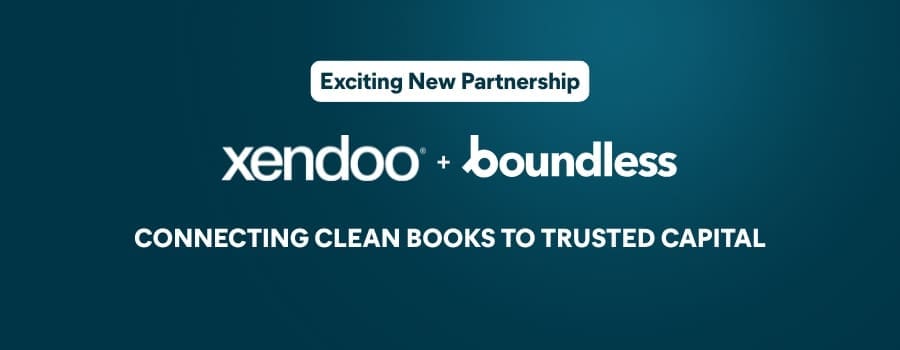Connecting Clean Books to Smarter Capital: The Xendoo + Boundless AI Partnership

The new partnership between Xendoo and Boundless AI bridges the gap between clean, up-to-date books and smart, accessible funding. Business owners gain accurate financials, real-time insights, and priority access to over 150 trusted lenders, all in one place. Together, Xendoo and Boundless AI help small businesses stay organized, secure capital faster, and make confident decisions to fuel growth. Financial Clarity Meets Funding with Xendoo + Boundless AI Partnership Behind every strong business is current, accurate financials. That’s what Xendoo delivers. Our dedicated team combines expert bookkeeping, accounting, and tax support with a proprietary dashboard that puts data-driven insights right at your fingertips. Business owners can track month-to-month trends, monitor key financial metrics, and access timely monthly reports, all in one place. Many business owners come to Xendoo with books that are months or even years behind, and no clear view of where their business stands. Our dedicated catch-up services get your financials current fast, restoring accuracy and making every report reliable. When your books are accurate and up to date, you see exactly what’s working and where to adjust. You know when to hire, when to expand, and where to manage costs to protect profits. Clean books turn ambitious plans into smart, well-timed action. Accurate financials also open the door to funding. Lenders expect transparent profit and loss statements, balance sheets, and cash flow summaries before they approve any loan or line of credit. Without them, funding simply isn’t an option. Xendoo is your trusted financial partner. We bring your books up to date quickly, deliver timely monthly reports, and keep you ready to move forward, no matter how far behind you start. With Xendoo, you have the numbers and the confidence to take the next step when the time is right. That is where Boundless AI makes the next step possible. We are thrilled to announce our new partnership with Boundless AI, a leading intelligent platform that connects entrepreneurs to trusted lenders and matches them with funding solutions built for their business goals. Why Xendoo Partnered with Boundless AI Growth should not stall because financials are not accurate. Xendoo catches your books up quickly, no matter how far behind, with a dedicated team that brings clarity and calm to your finances. But when it’s time to secure funding, the process can stall without the right connections. Once your books are caught up and your financials are accurate, Boundless AI removes that barrier, helping you take the next step with fast, flexible access to capital. Their intelligent platform matches entrepreneurs with funding options from a network of over 150 trusted lenders. It’s fast, flexible, and tailored to each business’s goals and risk profile, exactly what owners need when timing matters most. Together, Xendoo and Boundless AI close the gap between organized books and accessible capital. Your business stays loan-ready with timely profit and loss statements, balance sheets, and cash flow reports, and you gain a path to the funding that helps you hire, expand, or invest when the time is right. Who Benefits From This Partnership This partnership is designed for small business owners with a growth mindset, the builders, planners, and doers ready to take the next step. It’s for founders launching new ventures who need startup capital but don’t have spotless books yet. It’s for companies planning expansions, second locations, or new product lines that match their ambition with the right funding. It’s for seasonal businesses that need extra inventory to meet demand when it spikes. And it’s for owners who are ready to move past outdated lending processes that slow them down. Numbers alone don’t secure funding; numbers plus clarity and the right connections do. This partnership delivers both accurate books and a forward path to capital that supports growth. For Xendoo Customers: Xendoo users now receive priority access to Boundless AI’s capital marketplace, connecting them with more than 150 trusted lenders and funding partners. With books already current, Xendoo customers are in a stronger position to qualify and secure the best-fit funding for their goals. Check funding eligibility in minutes Get matched with the best-fit lenders and capital solutions for their business model Access funding options from $3,000 to $300 million, including lines of credit, term loans, revenue-based financing, and more Learn more by scheduling a free Boundless AI growth capital planning session. For Boundless AI Customers: Boundless AI users now gain the advantage of Xendoo’s expert bookkeeping and catch-up services to strengthen every funding opportunity. With accurate, up-to-date books, you’re better positioned to move quickly and present your business at its best. Get caught up fast with Xendoo’s dedicated bookkeeping team Access timely monthly profit and loss, balance sheet, and cash flow reports Make smarter capital decisions with full visibility into key financial metrics, expenses, and month-to-month trends Learn more by scheduling a free Xendoo accounting consultation. Built for Business Owners At Xendoo and Boundless AI, we know small businesses need more than outdated processes and one-size-fits-all solutions. Owners move fast; they need partners who understand the pace, the pressure, and the constant demands of running a business. We combine real human expertise with advanced technology because timely books and access to funding shouldn’t create more headaches. We’re modern by design. Our teams understand the tools, automations, and integrations that keep businesses moving efficiently and help owners stay ahead. We understand the pain points: falling behind on books, missing chances to grow, waiting weeks for answers from accountants and lenders who don’t understand your industry. Together, we remove that friction. You get timely books, data-driven insights, and a fast track to capital, all powered by smart technology and a team that understands what it takes to run a business today. The Future of Xendoo + Boundless AI The partnership between Xendoo and Boundless AI is just the beginning. Here’s what you can expect in the months ahead: Seamless integration: Direct links between your Xendoo dashboard and Boundless AI’s funding process, so accurate books flow straight into funding applications. Exclusive offers: Special savings and promotions
5 Reasons Bookkeeping Services are Essential For Businesses in an Uncertain Economy

Why Small Businesses Need Bookkeeping Services in a Changing Economy For many business owners, the economy feels uncertain. With unexpected market shifts, rising tariffs on outsourced goods, and steadily increasing costs, the path forward may feel uncertain. In moments like these, the pressure of every decision intensifies, yet the expectations remain. You are still expected to lead with confidence, adapt quickly, and keep the business afloat. In this environment, having reliable bookkeeping services becomes a strategic necessity, allowing you to operate from a place of control. When financials are accurate, timely, and accessible, you gain the clarity to respond with intention. Bookkeeping is now a steady source of insight that supports sound judgment, measured growth, and long-term resilience. What is the role of bookkeeping during a changing economy? Let’s explore how it can directly benefit your business. Here are five key advantages that make bookkeeping an invaluable asset, especially in today’s uncertain economic climate. Identify Financial Trends for Proactive Management When your books are consistently and accurately maintained, patterns begin to surface. Shifts like rising vendor costs, delayed customer payments, or narrowing profit margins rarely announce themselves with clarity. Instead, they appear subtly, through numbers that begin to drift off course. Bookkeeping brings those numbers into focus. Categorizing expenses, tracking receivables, and reconciling accounts regularly creates a living record of your business activity. This allows you to compare performance month over month, spot anomalies, and flag inconsistencies before they turn into larger issues. Early visibility means you’re not reacting after the damage is done, but you are adapting in real time to protect your margins and maintain stability. Financial Preparation for Loans, Grants, and Investors Loans, grants, investor inquiries, or relief programs require detailed financial documentation. Incomplete or outdated books can delay or disqualify you from accessing these resources. Well-maintained records provide a clear picture of your business’s financial health, enabling you to confidently present your case to investors or lenders, and respond quickly when time-sensitive opportunities arise. Visibility To Improve Business Decision Making In uncertain times, every business decision carries more weight. Whether you’re considering a new hire, adjusting pricing, or reworking your inventory strategy, understanding the financial impact in real terms, not broad estimates, is imperative. Bookkeeping provides that clarity by tracking and categorizing every transaction in your business. You see exactly how much revenue is coming in, where money is going out, and how those numbers shift over time. This level of detail allows you to monitor trends, spot inefficiencies, and plan based on facts. Accurate books connect the dots between your operations and your bottom line, so every decision is backed by real financial insight. Maximize Your Tax Savings with Accurate Bookkeeping A strong tax strategy begins with accurate books. When every transaction is recorded and categorized throughout the year, you enter tax season prepared, with clear documentation, organized records, and complete visibility into your financials. This foundation allows your CPA to move beyond basic filings and focus on optimizing your tax position. Whether it’s identifying eligible deductions, planning for quarterly payments, or aligning with your long-term financial goals, strategic decisions are only possible when your books are current. In a shifting economy, this level of preparation becomes a financial advantage. Save Time and Grow Your Business by Outsourcing Bookkeeping Services Bookkeeping requires consistency, precision, and time, pulling focus from the areas where your leadership creates the greatest impact. Delegating this responsibility to a trusted partner allows you to gain those hours back and reinvest them where they matter most: serving your customers, supporting your team, and shaping your next phase of growth. With xendoo Accounting, Bookkeeping, and Tax as your partner, your books are kept accurate and up-to-date by a team that delivers accurate financials on time, every time. Additionally, you gain exclusive access to our advanced technology platform, Insights XP. This powerful tool provides real-time insights into your financial landscape, enabling you to seamlessly track cash flow, monitor expenses, and evaluate your business’s financial health. You will always remain fully informed, empowering you to lead with clarity, focus, and forward momentum. Track your net income, revenue, and expenses month-to-month with Insights XP. Conclusion The ability to manage cash flow during market shifts with confidence is essential to your business’s success. By prioritizing reliable bookkeeping, you empower yourself with the clarity, insight, and preparedness needed to make informed decisions, seize opportunities, and stay aligned with your financial goals.
The Business Owner’s Guide to Paying Less in Taxes

Why Business Tax Planning Matters Welcome to the ultimate Business Owner’s Guide to Paying Less in Taxes. Many small business owners overpay in taxes simply because they miss out on deductions, tax credits, and strategic tax planning opportunities. Whether you’re a freelancer, eCommerce entrepreneur, or agency owner, this guide will help you understand how to legally lower your tax bill while keeping your financials in order. Without a solid business tax planning strategy, you risk paying more than you owe, missing deductions, or worse—triggering an IRS audit. The good news? Strategic tax planning and accurate bookkeeping can dramatically lower your tax bill while keeping your business compliant. What’s New for 2025 Tax Laws? Each year, tax laws change, affecting how much businesses owe. Keeping up with these changes ensures that small business owners claim every available deduction. Here’s what to watch for in 2025: Inflation-Adjusted Tax Brackets – The IRS has adjusted tax brackets to account for inflation, which may reduce your overall tax burden. Section 179 Deduction Limits – Higher limits allow businesses to deduct more on equipment, software, and business-use vehicles. Changes to Business Meal Deductions—The temporary 100% meal deduction has expired and will revert to 50%. R&D Tax Credit Expansion – If your business invests in technology or innovation, you may qualify for new business tax credits. Need help staying compliant? Catch up on bookkeeping before tax season to ensure accuracy and maximize deductions. How to Reduce Your Small Business Tax Bill 1. Keep Accurate Financial Records The biggest mistake small business owners make? Not keeping their books updated. Without proper financial records, you can’t claim business tax deductions or justify expenses to the IRS. Use a bookkeeping service to automate tax preparation and reduce errors. Separate business and personal expenses to avoid IRS scrutiny. Track mileage, home office deductions, and other tax-deductible expenses throughout the year. Keeping organized financial records ensures you never miss a deduction when filing your business taxes. 2. Choose the Right Business Structure Your business entity impacts how much you owe in small business taxes: LLCs & Sole Proprietors – Pay self-employment taxes but qualify for pass-through tax deductions. S-Corporations – Can reduce self-employment tax by splitting income between salary and distributions. C-Corporations – Benefit from a flat 21% corporate tax rate but may face double taxation. Not sure which business structure is best for tax savings? Talk to a tax expert to determine the right option. 3. Leverage Business Tax Credits Tax credits directly reduce your business tax bill dollar-for-dollar. Some of the most valuable small business tax credits include: R&D Tax Credit – You may qualify if your business invests in software development, technology, or innovation. Work Opportunity Credit – Hiring employees from certain targeted groups can earn your business tax credits. Utilizing available tax credits is a key tax-saving strategy that many business owners overlook. 4. Maximize Your Business Tax Deductions Many small business owners leave money on the table by failing to deduct all eligible expenses. Deduct these costs to reduce your taxable income: Business Insurance – Protect your company while lowering your tax burden. Office Rent & Utilities – Deduct costs for maintaining your office or workspace. Employee Salaries & Benefits – Payroll and employee benefits are fully deductible. Marketing & Advertising Costs – Business advertising, website expenses, and social media ads qualify. Home Office Expenses – If you operate from home, deduct a portion of rent, utilities, and internet costs. Maximizing business tax deductions helps reduce your overall tax liability and keeps more money in your business. Top Business Tax Deductions You Should Claim 1. Section 179 Deduction Deduct up to $1,160,000 2025 for business-use equipment, software, and vehicles. 2. Business Meals & Travel Claim 50% of meals with clients and business partners. Deduct 100% of travel expenses for business-related trips. 3. Retirement Contributions Contribute to a SEP IRA or Solo 401(k) to reduce taxable income while building long-term savings. 4. Health Insurance Premiums Self-employed? Deduct 100% of health insurance premiums for yourself and your family. By claiming every available deduction, your business can significantly reduce taxable income. Avoid These Costly Tax Mistakes Avoiding common small business tax mistakes can prevent penalties and lost deductions: Mixing Business & Personal Finances – Use a dedicated business bank account for transactions. Forgetting to Pay Estimated Taxes – If you’re self-employed, make quarterly tax payments to avoid penalties. Missing Tax Deadlines – Keep track of IRS filing deadlines to prevent late fees. Ignoring Bookkeeping Until Tax Season – Catch-up bookkeeping ensures accurate filings and maximized deductions. Avoiding these mistakes ensures your tax filings are accurate and free from IRS scrutiny. How xendoo Helps You Pay Less in Taxes At xendoo, our tax experts and CPAs help small business owners minimize tax liability and streamline business tax preparation. Here’s how we make tax season stress-free: Done-for-you bookkeeping & tax prep – Keep financials organized year-round. Catch-up bookkeeping for past-due taxes – No more scrambling at tax time. Tax-saving insights to maximize deductions – Ensure your business gets every eligible write-off. Hassle-free tax filing with real experts – Compliance and accuracy guaranteed. Keep More of Your Profits in 2025 This Business Owner’s Guide to Paying Less in Taxes has shown that overpaying is optional. Without a solid strategy, you risk paying more than you owe, missing deductions, or worse—triggering an IRS audit. This Business Owner’s Guide to Paying Less in Taxes helps ensure you don’t overpay. With smart tax strategies, you can legally reduce your tax bill and keep more profits. Taxes are unavoidable, but overpaying is optional. By maintaining organized financial records, claiming deductions, and working with tax professionals, your business can legally reduce its tax bill and keep more earnings. Want expert help reducing your business taxes? Schedule a free consultation today.
BBB + xendoo Webinar: Small Business Tax Write-Offs

Key Takeaways from the Webinar Our CEO and founder recently joined the Better Business Bureau (BBB) of South Florida for a webinar packed with practical accounting, bookkeeping, and small business tax write-off tips for small business owners. Whether you’re a startup, an e-commerce entrepreneur, or scaling your professional services, this webinar offers valuable financial advice to help you manage your business finances effectively. Below are some key highlights—but this is just the beginning. Watch the entire webinar for even more insights! How to Vet a CPA for Your Small Business Accounting Needs Choosing the right CPA can significantly impact your business’s financial health. Here are some essential questions to ask: Experience Matters: Ask how many years they’ve been in business and how many business tax returns they file annually. CPAs handling mostly personal tax returns might miss key business deductions. Industry Expertise: Ensure they are familiar with your specific industry, whether e-commerce, professional services, or manufacturing. Transparent Pricing: xendoo’s corporate tax returns start at $1,200, while market rates range from $1,500 to over $10,000—know what you’re paying for. Commonly Overlooked Small Business Tax Write-Offs Many small business owners miss out on valuable tax deductions. Here are some you should consider: Travel Expenses: Business-related travel, even part of a personal trip, is deductible. Section 179 Deductions: Large equipment purchases can significantly reduce your taxable income if your business is profitable. Maximizing Your Tax Savings with Small Business Tax Write-Offs Beyond deductions, there are strategic moves to save more on taxes: Track Personal Expenses: Any business-related expenses paid from personal accounts should be reimbursed and documented monthly. Augusta Rule: Rent your home to your business for up to 14 days per year, tax-free. S-Corp Election: Businesses earning over $30,000 in profit should consider an S-Corp election to save on self-employment taxes. Financial Health Tips for Small Businesses Staying financially healthy is about more than just tax savings: Monthly Financial Reviews: Regularly review your financial statements to keep your business on track. Checks and Balances: Separate financial roles within your team to prevent errors and fraud. Plan Early for Taxes: Start tax planning in Q4 to maximize deductions and reinvest in your business before year-end. Preserving Cash Flow and Managing Business Finances Cash flow management is critical to small business success. Here’s how to keep it strong: Avoid Credit Terms: Require upfront payments or credit card transactions to maintain steady cash flow. Manage Inventory Smartly: Don’t overstock—write off or donate unsellable inventory. Understand Your Cash Needs: Know how much cash your business needs to operate and secure a line of credit for emergencies. Watch the Full Webinar Want more in-depth small business accounting tips and financial strategies? Watch the webinar here to learn how to optimize your finances, improve your bookkeeping, and make your business thrive. Why xendoo Stands Out in Small Business Accounting xendoo isn’t just about numbers—we’re about people. Unlike traditional CPAs, who disappear after tax season, our team offers year-round support, expert bookkeeping, and personalized accounting services. We speak small business because we live it, providing tools and technology to make your financial management seamless and stress-free. Ready to Get Started? Schedule a free consultation today and mention the BBB webinar for personalized accounting and bookkeeping advice tailored to your business needs.
Guide to Tracking and Maximizing Tax Write-Offs

Tax write-offs are one of the most effective tools small business owners can use to reduce taxable income and keep more money in their business. But tracking and maximizing these deductions requires a strategic, year-round approach. This guide will help you understand tax write-offs, common mistakes, and practical strategies to ensure you’re not leaving money on the table. What Are Tax Write-Offs? Tax write-offs, also known as deductions, are expenses that the IRS allows you to subtract from your total income to reduce your taxable income. The result? You pay less in taxes. Write-offs cover a wide range of expenses, but only those that are considered “ordinary and necessary” for your business qualify. Examples include: Office expenses: Rent, utilities, and office supplies. Technology and tools: Software subscriptions, website hosting, and equipment. Travel costs: Flights, lodging, and meals during business trips. Marketing expenses: Social media ads, email campaigns, and graphic design fees. Knowing what counts as a deduction can have a significant impact on your tax bill. However, many small business owners miss out on these benefits simply because they fail to track their expenses properly. Why Tracking Expenses Year-Round Is Critical Many business owners wait until tax season to organize their finances, leading to overlooked deductions and unnecessary stress. Tracking your expenses consistently throughout the year ensures: Accuracy: You’ll have a clear record of deductible expenses when it’s time to file taxes. Preparedness: Avoid scrambling to find receipts or reconcile expenses. Savings: A well-organized system makes it easier to spot missed deductions. Simple ways to track expenses include: Using accounting software like QuickBooks or Xero. Dedicating a business bank account and credit card for all transactions. Keeping digital copies of all receipts. The Most Overlooked Tax Write-Offs Even the most diligent business owners can miss deductions. Here are some commonly overlooked write-offs: Home office expenses: If you work from home, you can deduct a portion of your rent or mortgage, utilities, and internet. Mileage: Track the miles driven for business using an app like MileIQ. Professional development: Expenses for training courses, certifications, and workshops qualify. Business meals: Meals with clients or team members are deductible at 50%. You’ll avoid leaving money on the table by staying informed about these potential write-offs. Strategies to Maximize Your Tax Write-Offs Maximizing deductions isn’t just about tracking every dollar—it’s about being proactive. Here’s how: Plan Ahead: Meet with a tax professional early in the year to discuss strategies tailored to your business. Organize Expenses by Category: Use clear categories like marketing, travel, and supplies to make deductions easier to claim. Review Past Returns: If you’ve missed deductions in prior years, consider filing an amended return. Proactive planning ensures you take advantage of every opportunity to reduce your tax liability. Tools and Best Practices for Streamlining Tracking Simplify the process of tracking your expenses with these tools and practices: Apps for tracking expenses: Try Expensify or Wave for easy expense management. Set up automation: Link your business accounts to software that automatically categorizes expenses. Review monthly: Dedicate time each month to review and reconcile your transactions. Creating consistent habits around tracking will save time and money when tax season arrives. The Role of Professional Bookkeeping Professional bookkeeping is a game-changer for small business owners. Having accurate, up-to-date books means: You’ll never miss deductions due to disorganized records. You’ll have clean financials ready for tax season and beyond. You can make informed decisions about growth and scaling. Bookkeepers don’t just organize your finances—they provide insights that help you plan for the future. Partnering with experts ensures that your business’s financial health stays a priority. Key Takeaways Tracking and maximizing tax write-offs doesn’t have to be overwhelming. You’ll unlock savings and gain financial clarity by staying organized, leveraging technology, and seeking professional support. Ready to start 2025 on solid financial footing? Begin by taking control of your write-offs today. Schedule a consultation to learn how xendoo can support your business’s bookkeeping, accounting, and tax needs.
The Complete Breakdown of a Fractional CFO

What Is a Fractional CFO, and Do I Need One? As your business grows, so do its financial complexities. You may find yourself needing more strategic financial guidance than a bookkeeper or accountant can provide but aren’t ready to hire a full-time Chief Financial Officer (CFO). This is where a fractional CFO can be the perfect solution. But what exactly is a fractional CFO, and how do you know if your business needs one? Let’s dive in. What Is a Fractional CFO? A fractional CFO is a highly experienced financial professional who works with your business on a part-time or contract basis. Instead of hiring a full-time CFO, which can be costly, you gain access to expert financial guidance and strategic planning for a fraction of the cost. Key Responsibilities: Financial Strategy Development: Helps set long-term financial goals and creates actionable plans to achieve them. Cash Flow Management: Ensures you have the liquidity to sustain operations and fund growth opportunities. Budgeting and Forecasting: Provides accurate financial projections to guide your decision-making. Financial Reporting: Delivers insights from your financial data to help you understand your business’s performance. Fundraising and Investor Relations: Assists in securing funding and managing relationships with investors or stakeholders. Risk Management: Identifies financial risks and implements strategies to mitigate them. Benefits of Hiring: Cost Efficiency: Provide top-tier expertise without the expense of a full-time hire. You only pay for the time and services you need. Flexibility: Whether you need help for a few hours a month or on an ongoing basis, fractional CFOs offer tailored services that adapt to your business’s needs. Scalability: Ideal for businesses in growth mode, offering strategic support to scale operations and manage increased financial demands. Expertise Without Overhead: You gain access to a seasoned financial professional with experience across industries, often bringing fresh perspectives and innovative solutions. Do I Need a Fractional CFO? Here are some common signs your business can benefit: 1. You’re Experiencing Rapid Growth Growth is exciting, but it also introduces new challenges, like managing cash flow, planning for expansion, and ensuring profitability. A fractional CFO can guide you through these complexities with a strategic approach. 2. You Need Help Securing Funding If you’re seeking investors, loans, or other forms of funding, a fractional CFO can prepare the financial documents, forecasts, and pitches needed to build confidence with stakeholders. 3. Your Financial Data Feels Overwhelming If your financial reports are hard to interpret or you’re unsure about your profitability and margins, a fractional CFO can translate the numbers into actionable insights. 4. You Want to Improve Profitability Identify inefficiencies, reduce unnecessary expenses, and implement strategies to increase your bottom line. 5. You’re Planning a Major Transition Whether it’s a merger, acquisition, or significant investment, a fractional CFO can provide the expertise to navigate these high-stakes decisions. 6. You Lack a Clear Financial Strategy If you’re operating without a solid financial roadmap, a fractional CFO can help create one, aligning your financial goals with your business objectives. How Does a Fractional CFO Work with Your Business? They typically operate on a flexible schedule, providing support remotely or in person, depending on your needs. They might work with your existing team or independently, focusing on specific projects or ongoing financial management. Engagement Models: Project-Based: For specific tasks like fundraising, restructuring, or financial planning. Ongoing Support: For continuous oversight and guidance over a set number of hours per month. Interim CFO: Filling the gap while you search for a permanent CFO. Is This Right for Every Business? Not all businesses need a fractional CFO. For startups or very small operations with straightforward finances, a bookkeeper or accountant may suffice. However, if your business is growing, evolving, or facing financial challenges, the expertise can be transformative. Conclusion A fractional CFO offers strategic financial expertise at a fraction of the cost of a full-time hire. If your business is navigating growth, managing complex finances, or planning for the future, this could be the missing piece to help you thrive. Evaluate your current financial needs and consider how a fractional CFO could provide the guidance and clarity to achieve your business goals.
5 New Year’s Resolutions for Small Business Success in 2025

Small Business Resolutions The beginning of a new year is a natural time for reflection and goal-setting, and this applies to businesses just as much as individuals. For small business owners, 2025 is full of opportunities to strengthen operations, build deeper customer connections, and achieve new milestones. To help you make the most of this year, here are five impactful small business resolutions designed to boost growth and efficiency while keeping your team and customers at the heart of everything you do. 1. Prioritize Digital Transformation Digital transformation has shifted from being an optional enhancement to a necessary evolution for businesses of all sizes. In 2025, small businesses that embrace technology will find themselves better equipped to adapt to market demands, reduce costs, and improve customer satisfaction. Leverage AI for Strategic Insights: AI tools can elevate your business planning and operations. For instance, tools like ChatGPT can assist in brainstorming content strategies, drafting compelling copy for marketing campaigns, or analyzing customer feedback to identify trends. By integrating AI into your workflow, you can save time and focus on creative decision-making, while improving the quality of your outputs. Strengthen Your Digital Security: As businesses increasingly rely on digital tools, cybersecurity becomes critical. Ensure your systems are protected by using strong passwords, enabling two-factor authentication, and investing in reliable security software. Regularly back up your data and train your team on recognizing potential threats, such as phishing attempts, to safeguard your operations. Click here to read Cybersecurity 101 for Small Businesses: Essential Tips to Protect Your Data. Integrate Cloud-Based Solutions: Transitioning to cloud-based tools for file storage, collaboration, and project management can boost efficiency and accessibility. Platforms like Google Workspace or Microsoft 365 allow your team to access files and work collaboratively from anywhere, making remote work and on-the-go productivity seamless. This also ensures your data is backed up and protected in secure, offsite servers. 2. Enhance Financial Management Sound financial management is one of the most important aspects of running a successful business, yet it’s often one of the most overlooked. In 2025, add to your small business resolutions to make financial organization and planning a top priority. Key strategies for improved financial health include: Regular Financial Reviews: Schedule time each month to review your income, expenses, and cash flow. This habit can help you identify patterns, spot inefficiencies, and plan for upcoming expenses. Tax Planning: Avoid scrambling during tax season by preparing throughout the year. Keep organized records of expenses and consult with a tax professional to maximize deductions. Outsource Accounting Tasks: If managing finances feels overwhelming, outsourcing can save time and reduce stress. Partnering with an expert service like xendoo ensures your bookkeeping and accounting are handled professionally, leaving you free to focus on growing your business. Being proactive about your finances helps you to make more informed decisions about investments, hiring, and expansion. 3. Focus on Customer Retention Attracting new customers is essential, but retaining existing customers is even more valuable. Studies consistently show that loyal customers spend more, refer others, and cost less to retain compared to acquiring new ones. Make 2025 the year you deepen your relationship with your current customers. Steps to enhance customer retention: Offer Personalized Experiences: Use customer data to tailor recommendations, emails, or promotions to individual preferences. For example, an online store might recommend products based on previous purchases. Implement a Loyalty Program: Reward repeat customers with points, discounts, or exclusive perks. These programs can encourage continued engagement and spending. Proactively Gather Feedback: Use tools like SurveyMonkey or Google Forms to collect customer feedback. This helps you identify areas for improvement and shows customers that their opinions matter. Small changes can make a big difference. For instance, a local fitness studio could offer a free personal training session after 10 class visits or send a personalized message to members congratulating them on reaching a milestone. These gestures build trust and goodwill, keeping your business top of mind. 4. Invest in Team Development A skilled, motivated team is a cornerstone of any thriving business. In 2025, prioritize your employees’ growth and well-being to create a strong foundation for success. How to invest in your team: Provide Ongoing Training: Equip employees with the skills they need to excel. Whether it’s customer service training, technical certifications, or leadership workshops, professional development opportunities keep your team sharp and engaged. Recognize and Reward Contributions: A simple acknowledgment of hard work goes a long way. Celebrate wins, highlight standout performances, and consider implementing incentives like bonuses or extra time off. Foster a Positive Workplace Culture: Create an environment where employees feel valued, supported, and heard. Regular one-on-one check-ins and open communication channels can make all the difference. For example, a tech support company might invest in ongoing training for its team to stay updated on the latest software and troubleshooting techniques. Not only does this improve the customer experience by resolving issues more effectively, but it also enhances employee confidence and satisfaction. 5. Expand Your Reach Through Strategic Marketing Marketing is the engine that drives visibility and growth. In 2025, resolve to make your marketing efforts more strategic, targeting the right audience with the right message at the right time. Ways to elevate your marketing strategy: Leverage Social Media Trends: Platforms like TikTok and Instagram continue to dominate, particularly with younger audiences. Short-form video content, behind-the-scenes glimpses, and user-generated content can boost engagement. Invest in Paid Advertising: Consider using tools like Google Ads or Meta Ads Manager to run targeted campaigns. Paid ads can drive immediate traffic and conversions, especially when paired with strong landing pages. Create Valuable Content: Blogs, videos, and downloadable resources establish your expertise and attract potential customers. For example, a fitness studio might create a free eBook with home workout tips to build brand awareness and grow its email list. Local businesses should also tap into community marketing opportunities. Partner with other local businesses for events or promotions, sponsor local initiatives, or optimize your Google Business profile to attract nearby customers. Elevate Your
Preparing for Your Business Exit: A Strategic Guide

Businesses can grow quickly, and when that happens, keeping your financials and data in order becomes crucial. Potential buyers want transparency and assurance that your business is running smoothly. That’s where exit planning comes in. By managing your business from day one as if you were going to sell it, you set yourself up for a smooth and profitable transition whenever the time comes. What is Exit Planning? Exit planning is the strategic process of preparing your business for its next phase—whether you’re looking to sell, pass it on to a family member, or wind it down. A well-executed exit plan maximizes the value of your business and ensures a seamless transition. By setting clear goals and building a strong strategy early, you protect what you’ve built and position yourself to achieve your financial goals. Preparing for a Successful Exit Define Your Goals and Timeline Setting goals and a timeline early on is critical for exit planning. Ideally, you’ll want to start this process 3 to 5 years ahead of time. This gives you enough runway to implement the changes that will drive the most value—whether it’s maximizing your sale price, ensuring a smooth handoff, or securing your employees’ future. A timeline keeps you focused. For example, aim to streamline processes over the next year to improve operational efficiency. Whether you implement project management software or improve customer service systems, these steps prepare your business for growth and a successful exit. Clean, Organized Financials and Data: The Foundation for Success Financial transparency and clean data are non-negotiable when preparing for an exit. Potential buyers will scrutinize your business’s numbers, and you need to be ready. Use Accounting Software: Programs like QuickBooks or Xero help keep your financials accurate and organized. Maintain Transparent Financials & Organize Contracts and Taxes: Ensure taxes are up to date, financial statements are accurate, and contracts are in good standing. Organized financials and records show buyers that your business is reliable. Conduct Audits: Regular audits catch issues early and build buyer confidence. Avoid Financial Red Flags: Keep personal and business finances separate, report consistently, and avoid over-reliance on any single client. But it’s not just about the numbers but also the data. Clean customer data, sales trends, and new customer acquisition costs give buyers a complete picture of your business’s health. If you start your business by tracking this data as if you were going to sell it one day, you’ll be in a much stronger position—whether you decide to exit or keep growing. Build Your Business with an Exit in Mind From day one, make your operations efficient and your company culture strong. Standard Operating Procedures (SOPs) keep things running smoothly, even when you’re not there. Buyers want to know that a business will run well in their absence. Just as important is your data strategy. Tracking metrics like customer acquisition costs, lifetime value, and sales trends tells the story of your business. Clean, organized data can be a game-changer—it shows potential buyers where your business has been and where it’s going. Having reliable data can be a lever you can pull to improve business outcomes. Strong data doesn’t just track history; it helps you adjust and fine-tune your business strategy to grow even more. Maximize Business Value The more value you build into your business, the better positioned you’ll be for a successful exit. Focus on key performance indicators (KPIs) like revenue growth, profit margins, and customer acquisition costs. Buyers want to see clear, data-driven insights into your business’s health. Regularly assessing these metrics allows you to make adjustments to optimize operations and drive profitability. Understand KPIs KPIs are unique to each business and are the key drivers of growth. Tracking these indicators—especially customer data and sales trends—will show buyers that your business isn’t just performing well today but has a clear path for future growth. With the right data, you’ll have the tools to make informed decisions that boost your business’s value. Conclusion Effective exit planning isn’t just about having an end in mind—it’s about building your business in a strong way from day one. By defining your goals, gathering and analyzing meaningful data, and keeping your books accurate and consistent, you set yourself up for success—whether you’re ready to sell tomorrow or in five years. Preparation is the key. When you prioritize financials and strong customer data, you increase your business’s value and ensure a smooth transition when the time comes. With xendoo, you’ll have the tools and insights to make your business buyer-ready and maximize its value. Take control of your business’s future today. Schedule a consultation with xendoo, and we’ll help simplify the exit process while positioning your business for long-term success. Your future starts now.
Mastering Your Shopify Accounting Challenges

Running an eCommerce store on Shopify is exciting, but with growth comes responsibility—especially when it comes to accounting. Whether you’re tracking inventory, managing payments, or keeping up with tax requirements, staying on top of your finances can quickly become overwhelming. But with the right approach, you can simplify your Shopify accounting process and stay focused on growing your business. 1. Syncing Your Shopify Store with Accounting Software Integrating accounting software can make managing the finances of your Shopify store much more efficient. Instead of manually tracking sales, expenses, and inventory, accounting software simplifies the process by automating these tasks, making everything simpler and more efficient. What does it mean to “sync” your store with accounting software? Syncing means connecting your Shopify store directly to an accounting platform like QuickBooks or Xero so that your sales data, expenses, and inventory are automatically updated in real time. Without this integration, you’d have to manually enter every sale, expense, and inventory change into a separate system, which can be time-consuming and prone to mistakes. How does this help? Syncing your Shopify store with accounting software pulls all the important financial information directly from Shopify. Every time you make a sale, the transaction is automatically recorded in your accounting system. If you buy inventory, that purchase is logged, and your inventory levels are updated. This integration keeps all your financial data in one place and updates it instantly. Why is this important? Here’s why syncing your Shopify store with accounting software is such a game-changer: Reduces Manual Work: You don’t have to spend hours manually entering sales, receipts, and inventory updates. The system does it automatically, saving you time and reducing the risk of errors. Real-Time Accuracy: Since your sales, expenses, and inventory are updated automatically, your financial reports are always up to date. This means you can quickly see how much money you’re making and spending without having to wait for someone to update your books. Minimizes Errors: Manual data entry can lead to mistakes—whether it’s entering the wrong sales figure or forgetting to update your inventory. Automated syncing makes less room for human error, which helps ensure your financial data is accurate. Easy Reporting: With all your financial data in one place, you can generate reports that show how your business is performing. Whether it’s a profit and loss statement or a balance sheet, having accurate, up-to-date information allows you to make smarter business decisions. 2. Managing Inventory and Cost of Goods Sold (COGS) Keeping track of your inventory is one of the most important parts of running a successful Shopify store. But it’s not just about knowing how many products you have in stock—accurately managing your inventory is key to understanding how much money you’re really making. This is where Cost of Goods Sold (COGS) comes into play. What is COGS? COGS refers to the direct costs involved in producing or purchasing the products you sell. This includes things like the cost of materials, manufacturing, and even shipping to get the product into your hands. It’s crucial because it directly affects your profits. If you don’t know how much each product costs to make or buy, it’s hard to determine how much profit you’re making on each sale. How does accounting software help? Shopify has built-in tools to track how much inventory you have, but it doesn’t always give you a full financial picture. That’s where accounting software comes in. When you pair Shopify with accounting software like QuickBooks or Xero, the software automatically tracks and calculates your COGS for each product. Here’s how it works: Every time you sell a product, the accounting software not only logs the sale but also adjusts your inventory levels and updates the cost associated with that sale. It takes into account things like discounts, shipping costs, and any other expenses related to the product, so you get an accurate calculation of your profit. 3. Sales Tax Compliance Simplified Sales tax can get complicated on the Shopify platform. Different states and regions each have their own rules about when and where sales tax needs to be collected. It’s not as simple as applying one tax rate to every sale—local laws and thresholds vary depending on where your customers are located, making the process more complex than it seems. For example, in some states, you might be required to collect sales tax if your sales exceed a certain amount, but in others, you might not have to collect anything unless you have a physical presence there. Keeping track of these varying rules while also running your business can quickly become overwhelming. How can sales tax automation tools help? Sales tax automation tools, such as Avalara or TaxJar, integrate directly with your Shopify store and handle the heavy lifting for you. These tools are designed to track all of the different rules in each state or region and calculate the correct amount of sales tax for each purchase automatically. You won’t have to manually calculate tax rates for each customer or worry about changes in tax laws. The software stays updated with the latest rules, so you always collect the correct amount. Here’s how it works: Let’s say a customer in New York buys a product from your store. Instead of you having to figure out what the current tax rate is for New York and whether you’re required to collect tax there, Avalara or TaxJar will automatically calculate the exact amount and apply it to the transaction. It will even update your records in real time, so every sale is properly accounted for. Why is this important? Sales tax compliance is not something you want to overlook. If you’re not collecting the correct amount, you could face penalties or audits from tax authorities, which can be costly and time-consuming. By using automation tools, you avoid these risks and ensure that your business is always in compliance. 4. Understanding Payment Gateways and Fees When running a Shopify store, you’re likely using payment gateways such as Shopify
Choosing the Right Accounting System for Your Shopify Business

Editor’s Note: This post was originally published in October 2017 and has been updated for accuracy and comprehensiveness. Whether you’re brand new to online retail and trying to decide how to set up your eCommerce business, or you’ve been around a while and simply reached the point where your DIY accounting solution just isn’t cutting it anymore, xendoo’s innovative suite of business offerings can help you. xendoo can get your small business accounting running like a well-oiled machine so you can focus on what’s important – growing your business. To be competitive in the new economy, cloud-based accounting is no longer a luxury; it’s a necessity. Here are some of the best accounting systems for Shopify that can help get your business on track. QuickBooks Online QuickBooks Online is the cloud-based version of the popular and versatile QuickBooks business accounting software. Quickbooks Online accounting system for Shopify allows you to access your account information from any web browser, and the API creates a seamless interface that links directly to xendoo’s platform. That means you can easily organize and sync all of your critical financial data with no tedious manual data entry. Additionally, Quickbooks Online for Shopify allows you to easily create and send invoices, receive payments, pay bills, and manage payroll. Track income and expenses Capture and organize receipts according to your chart of accounts Download and organize bank account and credit card transactions Print checks Create and send invoices, as well as receive payments Print financial reports Tax organization Xero for E-commerce QuickBooks is a popular accounting system for Shopify, but it may not be the best choice for everyone. Xero is another cloud-based accounting solution that will appeal to a lot of Shopify store owners. Xero is fast, simple, and powerful. It can sync with hundreds of third-party applications for point-of-sale, inventory, and much more. It also offers a mobile app for convenience and allows customers to create an unlimited number of users. From within the Xero accounting software for Shopify, you can manage your accounts payable, accounts receivable, budget, and category or division tracking. Customizable dashboard Create invoices and quotes and receive payments Track inventory Bill payment Expense management and project management Create and print financial reports Bank account reconciliation Highly scalable for small or growing businesses A2X for Shopify A popular middleware, or “connector,” application that links your Shopify store with your cloud-based accounting system is A2X for Shopify. It automatically posts your Shopify sales and fees directly into QuickBooks or Xero, saving you hours of tedious work each week. That also means no more stressing over why transactions don’t match your bank deposits because A2X eliminates data entry mistakes. Automatically post store data into QuickBooks or Xero Automatically reconcile bank statements Automatically make adjustments for fees and refunds Create and print summarized statements TaxJar for Shopify A major time vampire for business owners who sell on Shopify is state sales tax compliance in the wake of Wayfair, Inc. v. South Dakota (2018), which requires online sellers to comply with sales tax requirements in each state where they do business. TaxJar accounting system for Shopify will streamline your sales tax compliance process by showing you where you should be collecting sales tax according to economic nexus laws and generating return-ready reports. It can even auto-file your returns for you if you want. Calculate sales tax based on each state’s nexus Daily updates allow for timely return filing AutoFile option for automated return filing Display fines and penalties for delinquent filing Compare actual collections to what should have been collected Shopify Apps In addition to your accounting software, Shopify offers over 1,000 plug-in applications from their app store to help you with managing inventory, shipping, reporting, and much more. However, we suggest that you fully explore the capabilities of QuickBooks, Xero, A2X, and TaxJar before making any decisions about additional applications. A lot of functionality might be duplicated, and you certainly don’t want to pay for the same thing twice. In addition to tons of helpful plug-ins, Shopify also features a profit margin calculator. Just plug in your cost of the item and a markup percentage, and Shopify will calculate the sale price, your gross profit in dollars, and your gross margin. Outsourcing Your Bookkeeping and Accounting Even though these accounting systems for Shopify can make life much simpler for sellers than even just a few years ago, it can still sometimes feel overwhelming. If you begin to feel like you might be in over your head, you should consider outsourcing your accounting and bookkeeping to a small business accounting firm like xendoo. There are a lot of good reasons to outsource your accounting for your Shopify eCommerce business, and it’s more affordable than you might think. xendoo’s accounting team works with small business owners just like you to provide expertise and insight into the accounting needs of e-commerce businesses. xendoo can take care of everything from weekly bookkeeping to filing business taxes for you, and our flat monthly fee is less than half of what you’d probably pay an accountant. xendoo’s mission is to give you the peace of mind of knowing it’s being done right, and free your time to focus on what’s important – growing your business. Sign up for a free trial today. [av_sidebar widget_area=’Blog Post Disclaimer’ av_uid=’av-om2w’]